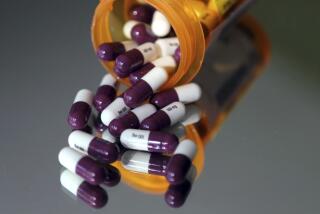Day of Decision for Silicone Implant Recipients : Health: For about 1,000 local women with ailments, today is the deadline to accept a product-liability settlement from manufacturers or pursue individual lawsuits. The financial variables are many.
- Share via
Claudia Roberts wrestled with all the issues--medical, legal, financial and emotional--and tentatively decided to accept the settlement offer that silicone breast implant manufacturers are extending to women who believe the devices have destroyed their health.
“I am trying to be optimistic,” said Roberts, 43, one of about 1,000 Orange County women who, like their counterparts across the country, face a court-established deadline today to decide whether they want to reject the settlement and pursue their own lawsuits.
Roberts expects to receive $450,000 to compensate her for the chronic fatigue, joint pain and headaches she blames on breast implants she had for seven years, before they were surgically removed 19 months ago. She said she wants to tuck the money in a savings account to help her two children through college in case her health worsens and she can’t continue working as a hairstylist.
“I don’t seek retaliation, just some future security for my family’s welfare, so I am not a burden,” she said.
Manufacturers of silicone breast implants have offered a settlement of up to $4.3 billion. They contend that will be enough to give each claimant in the United States between $105,000 and $1.4 million, depending on her illness, its severity and her age when she became sick. The hitch is that the awards could be reduced if there are more eligible claimants than anticipated.
If award reductions occur, the women will have an opportunity to back out of the settlement. But if too many women pull out, the settlement will fall apart.
“I think a lot of women are going into it with the understanding there is a reasonable chance it won’t work, that too many will qualify and there won’t be enough money in the fund,” said attorney Ramon Rossi Lopez, whose Newport Beach firm represents about 500 women with silicone breast implant complaints.
Lopez estimates that, despite the uncertainty, 80% to 90% of women with silicone breast implant complaints will cast their lots with the settlement. He also predicts that the manufacturers will beef up their existing settlement offer, even if it means adding billions of dollars, rather than incur the expense of fighting thousands of individual lawsuits.
Lopez said that about half of his clients would be content with the payment schedule that is projected in the settlement, while others would accept it just to avoid the delays and emotional strain of the court process.
Some women, he conceded, would have trouble pursuing their own product-liability lawsuits because they failed to file suit within the legal time frame. Others would have difficulty proving that the silicone was responsible for their symptoms. Still others, he said, have been unable to identify the manufacturers of their implants, or the manufacturers have gone bankrupt, making it unproductive to sue them for damages.
The settlement deadline comes two days after the New England Journal of Medicine published a study that found no evidence that silicone breast implants cause illnesses. Lopez said he worries that the study could scare women into the settlement who would be better off taking their cases to court.
A woman pursuing a product-liability lawsuit against a silicone breast implant manufacturer would need to prove that silicone migrating from the implant into her body triggered her health problems. However, a woman who accepts the settlement would not have to prove silicone was to blame.
“I think (publicity about the study) will influence some people on the fence to opt into the settlement,” said Lopez, who contends that the study conducted at the Mayo Clinic was “biased” because it was sponsored by plastic surgeons and did not look for the kind of novel autoimmune diseases from which his clients suffer. Ann Andrews, a plaintiff attorney in Long Beach, also complained about what she called a “well-timed” warning from Dow Corning Corp.--once the leading manufacturer of silicone breast implants--that if too many women opt to pursue individual lawsuits, the company would consider filing for bankruptcy protection. This also is pressuring women to settle, she contends.
Andrews cautioned that the settlement has shortcomings. For one, she said, a team of claims adjusters may determine that a woman’s medical records do not substantiate the amount of damages she is demanding. As a result, she said, a woman may be pushed into a lower-paying category.
Many women were still in a quandary whether to jettison the settlement in the last days before the deadline. Richard Radcliffe, a Newport Beach attorney, said he had received eleventh-hour calls from hundreds of women. “It is difficult for them to find lawyers with the expertise or interest in handling these matters,” Radcliffe said.
If women do not mail an exclusion form by today’s deadline, they will automatically remain in the class action. But some women who requested an official settlement information packet will have until the end of the month to make up their minds, if the packet was mailed to them on or after June 1.
Women rejecting the settlement, the lawyers say, are primarily those with the most severe disabilities and income losses who feel they would be grossly undercompensated.
Marie Walsh of Laguna Hills, founder of the Orange County-based Breast Implant Information Foundation, said she is determined to go ahead with her lawsuit. Walsh, who had breast implant ruptures, said although her diseases--including scleroderma, lupus and rheumatoid arthritis--would qualify her for the top $1.4-million settlement award, that would fall far short of her losses.
“The settlement would not compensate the pain and suffering, future medical expenses and loss of future wages,” said Walsh, 48, who is on Social Security disability. Walsh, who suffered severe scarring from multiple operations on her breasts, said another shortcoming of the settlement is that it does not offer compensation for disfigurement.
Melody Mello--who, like Walsh, is an outspoken advocate for breast implant victims--said she also is forging ahead with her lawsuit, which is scheduled for trial in September.
The Costa Mesa woman said she is skeptical about the proposed breast implant settlement, fearing that the final outcome will repeat the frustrating history of the settlement involving the Dalcon Shield, a defective intrauterine birth control device.
In the Dalcon Shield case, a trust fund of $2.5 billion was set up by the American Home Products Corp. in 1985 to compensate 325,000 women who filed lawsuits. As of last December, 85% of those eligible had been paid $935 million.
Mello has a letter from a woman in the Dalcon Shield settlement who has received only $725 after nine years and now, as a silicone breast implant claimant, is choosing to opt out of this latest settlement. “For me it is deja vu,” wrote the woman, whose identity Mello withheld.
More to Read
Sign up for Essential California
The most important California stories and recommendations in your inbox every morning.
You may occasionally receive promotional content from the Los Angeles Times.










